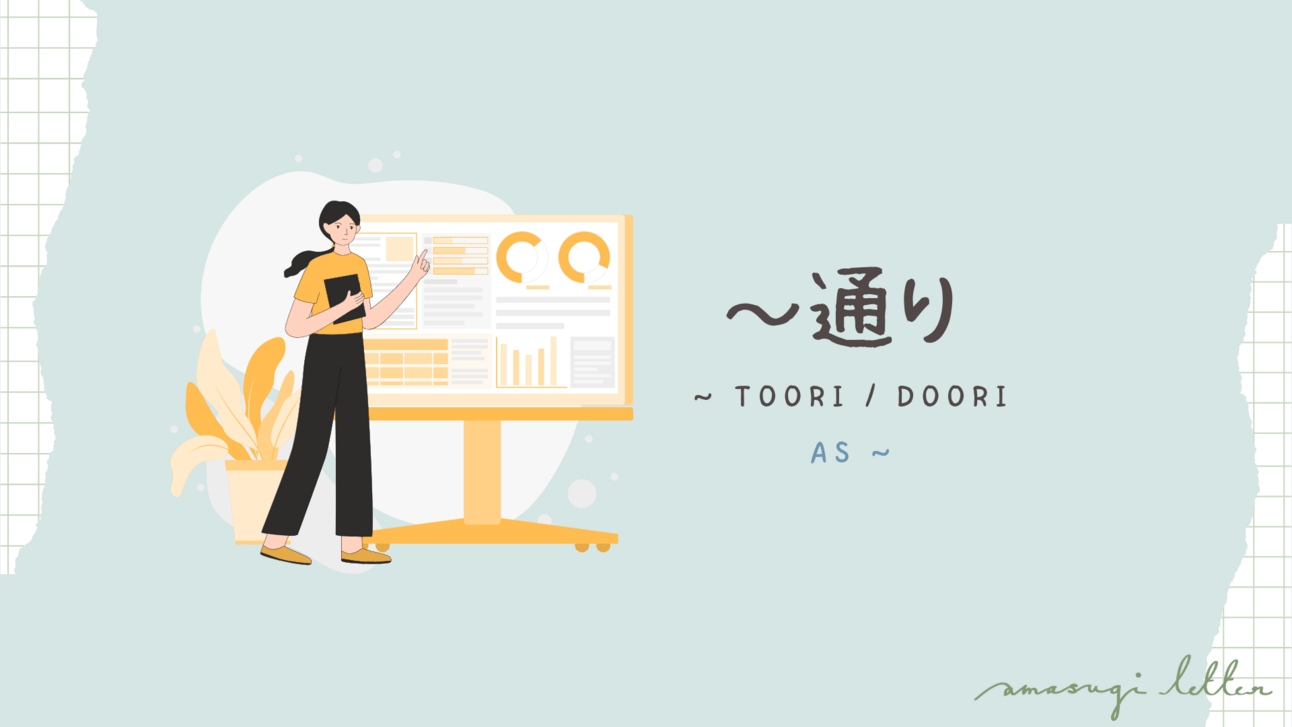- Amasugi Letter
- Posts
- 何の言葉25 ~通り (~toori/doori)
何の言葉25 ~通り (~toori/doori)
Amasugi Letter

Hi!
I was talking to my friend, and she shared with me an embarrassing story about her meeting with her boss and clients.
She prepared her presentation diligently and was ready to present her ideas.
「このグラフのとおり… あっ!」
“According to the graph.. ah!”
She used the wrong graph, and almost became speechless in that moment.. 😲
Somehow she managed to cover it up by explaining a different scenario, and she did so well her boss was very impressed and said 「いつも通り、いいプレゼンだったね」which means “As always, you did a great presentation”.
Luckily, no one noticed her mistake because she planned so well on other parts of her presentation. All that hard work paid off 💪
So today’s word is useful if you likes things going according to plan!


What does ~通り mean?
~通り(~toori/doori)=in the same way as was stated/shown/thinks etc.
通り on its own means “street” or “road”. But when combined with a noun or verb before it,~通り it becomes a grammar rule.
We selected a few common ways to use ~通り, such as when:
Speaking or listening
言う通り = Just as he/she says; What he/she said was right
(iu toori)指示通り = per instruction
(shiji doori)
Reading or seeing
以下の通り = as mentioned below
(ika no toori)この通り = like this
(kono toori)メールに書かれている通り = as mentioned in the email
(meeru ni kakarete iru toori)
Thinking
思った通り = as I thought
(omotta toori)思い通り = as one pleases; wants
(omoi doori)
Timing
時間通り= on time, punctual (following the time)
(jikan doori)いつも通り = as always
(itsumo doori)カレンダー通り = as following/per/according to the calendar
(karendaa doori)
Phrases
文字通り = literally
(moji doori)一通り = skimmed through; went through (something) without so much detail
(hito toori)
How to write and read ~通り
It is usually written in kanji, but sometimes written in hiragana as とおり to avoid confusion when reading.
Similar English phrases:
“according to ~”
“as per~”

💡 Street names with 通り
If you search the maps, you will find that street names in Japan are written like this:
中央通り in Tokyo
(chuuou doori)千日前通り in Osaka
(sennichimae doori)七条通り in Kyoto
(shichijou doori)
Like how street names in London are named as “Oxford Street” or “Abbey Road”, in Japan, street names have the word 通り (doori) at the end.
However, if we were to translate “Oxford Street” or “Abbey Road” into Japanese, it would be written in katakana オックスフォード・ストリート (okkusofoodo sutoriito) and アビー・ロード (abii roodo)!
Streets can also be described as below:
大通り = main street
(oo door)海岸通り = road near the beach/ocean
(kaigan doori)

1.新幹線は予定通りに出発したよ。
(Shinkansen wa yotei doori ni shuppatsu shita yo)
The shinkansen has departed as scheduled.
2.あなたの言う通り、このゲーム、すごくおもしろかった。
(Anata no iu toori, kono geemu, sugoku omoshirokatta)
Just as you said, this game was very fun.
3.前に話した通り、今週は出張があるからね。
(Mae ni hanashita toori, konshuu wa kaigai shucchou ga aru kara ne)
As I told you before, I have a business trip this week, you know?
4.会議の場所と時間は、メールに添付の通りです。
(Kaigi no basho to jikan wa, meeru ni tenpu no toori desu.)
The meeting place and time is as attached in the email.
5.両親の期待通り、いい大学に入った。
(Ryoushin no kitai doori, ii daigaku ni haitta.)
As my parents expected of me, I entered a good university.
Similar Japanese phrases:
~ように (~ you ni)
Let us know if you have any questions about ~通り.
Til our next newsletter!👋
Sincerely,
Amasugi Letter
Send us your feedback → [email protected]
Follow us on instagram → @amasugiletter
Check out our website → amasugi-letter.beehiiv.com
Reply